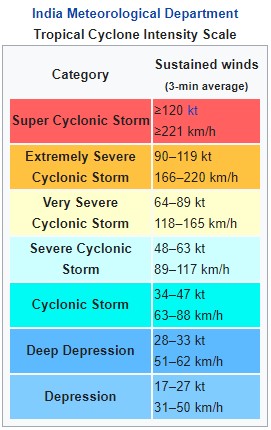Contents
- Severe Cyclonic Storm ‘AMPHAN’
- Advance of southwest monsoon
- Invalid FASTag to be charged double toll Fee
- NIF’s Challenge COVID-19 Competition (C3)
SEVERE CYCLONIC STORM ‘AMPHAN’
Focus: GS-I Geography, Prelims
Why in news?
- The Very Severe Cyclonic Storm ‘AMPHAN’ (pronounced as UM-PUN) over central parts of South Bay of Bengal moved northwards on 17th May, 2020.
- It is very likely to intensify further into an Extremely Severe Cyclonic Storm during next 24 hours.
- It is very likely to move nearly northwards slowly during next 12 hours and then re-curve north-northeastwards and move fast across northwest Bay of Bengal and cross West Bengal – Bangladesh coasts by 20th May 2020 as a Very Severe Cyclonic Storm.
Tropical Cyclone Scales
- Tropical cyclones are ranked on one of five tropical cyclone intensity scales, according to their maximum sustained winds and which tropical cyclone basin(s) they are located in.
- Any tropical cyclone that develops within the North Indian Ocean between 100°E and 45°E is monitored by the India Meteorological Department (IMD, RSMC New Delhi).
Classification in North Indian Ocean

- The lowest official classification used in the North Indian Ocean is a Depression, which has 3-minute sustained wind speeds of between 17–27 kn.
- A Deep Depression has winds between 28–33 kn.
- When it develops gale-force wind speeds of between 34–47 kn, it is classified as Cyclonic Storm and assigned a name by the IMD.
- Very Severe Cyclonic Storms have hurricane-force winds of 64–89 kn (73–102 mph; 118–166 km/h).
- Extremely Severe Cyclonic Storms have hurricane-force winds of 90–119 kn (166–221 km/h, 104–137 mph).
- The highest classification used in the North Indian Ocean is a Super Cyclonic Storm, which have hurricane-force winds of above 120 kn (138 mph; 222 km/h).
Click Here to read more about the Formation of Tropical Cyclones
ADVANCE OF SOUTHWEST MONSOON
Focus: GS-I Geography, Prelims
Why in news?
The National Weather Forecasting Centre/Cyclone Warning Division of the India Meteorological Department said The Southwest Monsoon has advanced into some parts of south Bay of Bengal, Nicobar Islands & Andaman Sea.
Major features associated with advance of southwest monsoon
South-westerly wind has strengthened in the lower levels (up to 25 knots) and deepened (up to 6 km) over the southern Latitudes covering south Andaman Sea, Nicobar Islands and southern parts of south Bay of Bengal.
The Satellite (INSAT-3D) derived Outgoing Long wave Radiation over the region is less than 200 W/m2.
Click Here to read more about Monsoon and Indian Ocean Dipole
INSAT-3D
- INSAT-3D is a meteorological, data relay and satellite aided search and rescue satellite developed by the Indian Space Research Organisation (ISRO) and was launched successfully on 26 July 2013.
- The mission goal is stated as “to provide an operational, environmental & storm warning system to protect life & property and also to monitor earth’s surface and carryout oceanic observations and also provide data dissemination capabilities.”
INVALID FASTAG TO BE CHARGED DOUBLE TOLL FEE
Focus: GS-III Science and Technology
Why in news?
- The Ministry of Road Transport and Highways has issued notification for amendment in the National Highways Fee (Determination of Rates and Collection) Rules, 2008 which provide that if a vehicle which is not fitted with FASTag or the vehicle is without a valid or functional FASTag, enters into “FASTag lane” of the Fee plazas, then they shall pay a fee equivalent to two times of the fee applicable to that category of vehicles.
- Before this amendment, the user of vehicle was to pay twice on the fee plaza only if the vehicle didn’t carry the FASTag and entered in dedicated FASTag lane.
FASTag
- FASTag is an electronic toll collection system in India, operated by the National Highway Authority of India (NHAI).
- It employs Radio Frequency Identification (RFID) technology for making toll payments directly from the prepaid or savings account linked to it or directly toll owner.
- As per NHAI, FASTag has unlimited validity. 7.5% cashback offers were also provided to promote the use of FASTag.
- Dedicated Lanes at some Toll plazas have been built for FASTag.
- On 15 December 2019, FASTag became mandatory throughout India.
Advantages of Using FASTag
- Digital transaction makes it easier to collect toll fees.
- Congestion in Toll plazas will reduce.
- Non-stop movement at the highways will reduce Fuel consumption and even pollution.
- The Effort in Managing toll gates is reduced as the system is more automated.
- There will also be reduced paper wastage (in the form of tokens/receipts)
- This will be a unifying system as FASTags are not specific to the state or region and work all over India.
Problems with FASTag
- Technical issues and glitches are possible which makes the system susceptible to false charges or other such issues.
- All the toll booths are yet to be made FASTag compatible and this has not necessarily reduced the congestion issue yet.
- The RFID technology is not failproof and can be misused by duplication or other “hacks”.
- The FASTags sold by banks have to be recharged from the same bank, as they are not Bank Neutral (unless you buy it directly from NHAI).
NIF’S CHALLENGE COVID-19 COMPETITION (C3)
Focus: GS-III Science and Technology, Prelims
Why in news?
- The National Innovation Foundation – India (NIF), an autonomous body of the Department of Science and Technology (DST) has identified several S&T based innovative solutions through the Challenge COVID-19 Competition (C3), a campaign which was running from 31st March to 10th May 2020 for engaging innovative citizens to come up with ideas and innovations to tackle the pandemic.
- NIF is providing incubation and mentoring support for further dissemination to the generator of the ideas.
- A foot-operated device for hand sanitization and washing and an innovative sprayer for sanitizationare the two recently supported innovations under the campaign.




